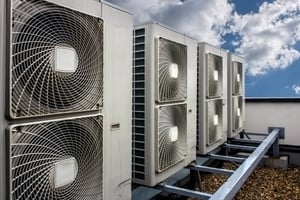Share this
Are You Managing Your Energy Spend?
by Phoenix Energy Technologies on Aug 5, 2019
 Running Building Systems Can Be Counterintuitive
Running Building Systems Can Be Counterintuitive
Buildings are made to run better when they are set at an optimal setpoint. Setpoint is the target value that a thermostat is set to.
For a building with only heating, you'll only need to work with heating degree days, so you'll only need to estimate the heating base temperature. Similarly, for a building with only cooling, you'll only need to work with cooling degree days, so you'll only need to estimate the cooling base temperature.
For a building with both heating and cooling, you'll need to estimate the heating base temperature and the cooling base temperature as you'll be working with both.
Different locations will be subject to different variants in outside temperature, so there would be no reason to select one arbitrary setpoint for multiple locations. Each location should have its own setpoint.
Buildings are designed to protect humans from the elements. Most common insulation materials work by slowing conductive heat flow and, to a lesser extent, convective heat flow.
Radiant barriers and reflective insulation systems work by reducing radiant heat gain.
Regardless of the mechanism, heat flows from warmer to cooler until there is no longer a temperature difference.
Buildings should also provide comfort in terms of temperature. But the comfort threshold is different in men than in women and women are especially prone to getting cold in office buildings in the summer.
Buildings also provide safety, i.e. when HVAC redirects ventilation during a fire and when elevators are redirected to the ground floor and locked down, in the case of an earthquake or a fire.
Ways for building managers to make buildings efficient
Energy efficient buildings (new constructions or renovated existing buildings) can be defined as buildings that are designed to provide a significant reduction of the energy need for heating and cooling, independently of the energy and of the equipment that will be chosen to heat or cool the building.
Cycling down HVAC in unoccupied space is not the solution!
It can actually can cost you more as the setpoint is never reached, so overcompensation happens. And, in some instances it’s illegal, as is the case in California with title 24.
Title 24 is a broad set of requirements for “energy conservation, green design, construction and maintenance, fire and life safety, and accessibility” that apply to the “structural, mechanical, electrical, and plumbing systems” in a building.”
A demand-side energy management tool can assist with the precise calculations across hundreds of locations for the perfect setpoint at any given point in time.
PhoenixET can provide help in calculating this unique, precise setpoint for hundreds of locations daily, within a fraction of a degree to keep buildings at their ideal setpoint between 70-76 degree range.
For more information on our solutions, click here.
Related Posts
What Facility Managers Need to Know About Load Shifting - Part 1
Adaptive Energy Management Guide
4 Common Myths of Energy Conservation in Building Management
Precision Building Management: Understanding Closed Loop Control
Share this
- Facilities Management (91)
- Energy Management (69)
- Company News (49)
- Smart Buildings (37)
- Retail (36)
- Building Management (24)
- Building Automation Systems (21)
- Sustainability (20)
- Energy Demand Management (19)
- EEI (15)
- Adaptive Energy Management (14)
- Grocery (14)
- demand response (14)
- Artificial Intelligence (12)
- Data Integration and Visibility (10)
- HVAC IQ (9)
- COVID-19 (8)
- Customer Spotlight (8)
- Carbon Management (7)
- Setpoints and Temperatures (7)
- Equipment Maintenance (6)
- Operational Efficiency (6)
- Refrigeration Optimization (6)
- Ask Ron (5)
- Asset Manager (5)
- Finance and Procurement (5)
- IoT and Digital Transformation (5)
- Awards (4)
- Comfort (4)
- Energy & Store Development (4)
- Safety and Compliance (4)
- Demand Charge Management (3)
- Energy Management System (3)
- Lifecycle Asset Management (3)
- Premium Services (3)
- Refrigeration IQ (3)
- Automated Demand Response (2)
- ConnexFM (2)
- Customer Service (2)
- HVAC Vendor Management (2)
- Load Shedding (2)
- Technician View (2)
- AIM Act (1)
- ALD (1)
- Analytics (1)
- Data (1)
- Data Integration and Visualization (1)
- EMS (1)
- Knowledge Center (1)
- OSHA (1)
- asset management (1)
- December 2025 (1)
- November 2025 (1)
- October 2025 (2)
- September 2025 (1)
- August 2025 (3)
- July 2025 (1)
- June 2025 (1)
- May 2025 (2)
- March 2025 (2)
- February 2025 (1)
- January 2025 (2)
- December 2024 (2)
- October 2024 (1)
- September 2024 (1)
- August 2024 (2)
- June 2024 (2)
- April 2024 (2)
- March 2024 (2)
- January 2024 (1)
- December 2023 (1)
- October 2023 (2)
- September 2023 (2)
- August 2023 (2)
- July 2023 (1)
- May 2023 (2)
- April 2023 (2)
- March 2023 (3)
- February 2023 (1)
- January 2023 (1)
- December 2022 (1)
- November 2022 (2)
- October 2022 (2)
- September 2022 (1)
- May 2022 (2)
- April 2022 (1)
- March 2022 (3)
- February 2022 (2)
- January 2022 (4)
- December 2021 (2)
- November 2021 (3)
- October 2021 (1)
- September 2021 (3)
- August 2021 (4)
- July 2021 (1)
- June 2021 (2)
- May 2021 (1)
- January 2021 (2)
- December 2020 (2)
- November 2020 (2)
- October 2020 (3)
- September 2020 (4)
- August 2020 (3)
- July 2020 (2)
- June 2020 (3)
- May 2020 (3)
- April 2020 (5)
- March 2020 (5)
- February 2020 (4)
- January 2020 (4)
- December 2019 (4)
- November 2019 (3)
- October 2019 (4)
- September 2019 (5)
- August 2019 (4)
- July 2019 (4)
- May 2019 (2)
- April 2019 (3)
- February 2019 (1)
- December 2018 (1)
- November 2018 (1)
- October 2018 (3)
- September 2018 (3)
- August 2018 (3)
- July 2018 (3)
- June 2018 (3)
- May 2018 (1)
- June 2015 (1)
- March 2013 (1)
- January 2013 (1)
- December 2011 (1)
- October 2011 (1)
- September 2011 (1)



